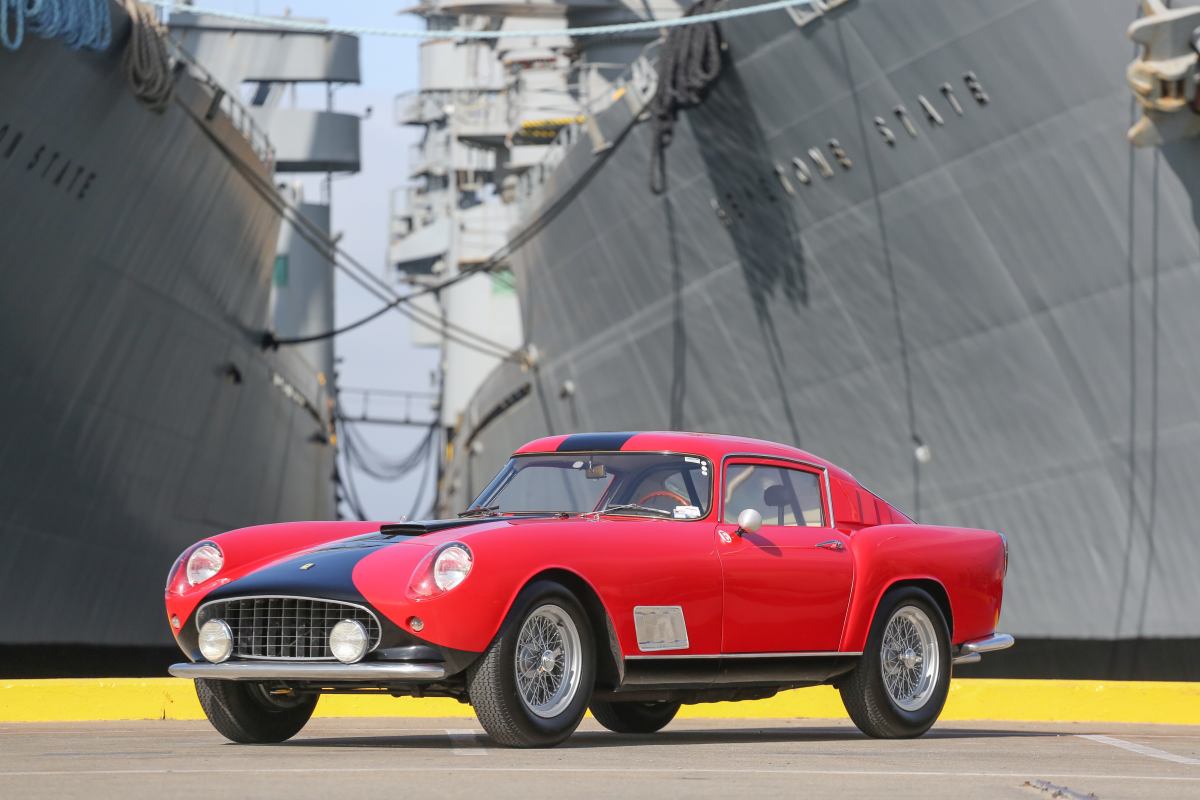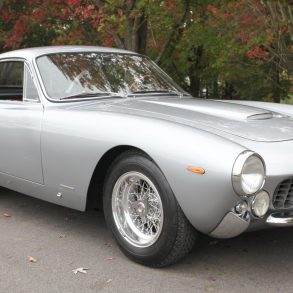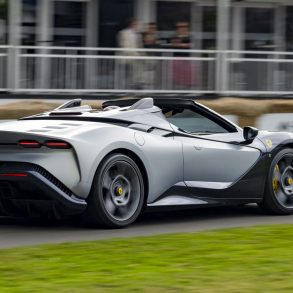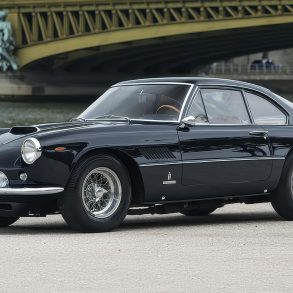The Ferrari 250 GT is known for their formidable engineering, beautiful design, and exceptional racing performance. In the mid-1950s, the model placed Ferrari at the peak of Gran Turismo racing. The Ferrari 250 GT is the perfect example of performance excellence both for historians and collectors alike. As a predecessor of the 250 GT SWB and the 250 GTO, the Ferrari 250 GT Berlinetta Tour de France is still one of the most desirable and collectible models today.
The allure of the Ferrari 250 GT is somewhat because of the multiple successes the automobile provided in many of the most onerous period races; and it proceeds to do so in contemporary vintage events throughout the world today. To this day, rare competition examples of the Ferrari 250 GT Berlinetta Tour de France with decorated provenance, detailed documentation, as well as exciting historic contexts remain profoundly sought after. This is due to the combination of stunning Scaglietti coachwork, excellent performance qualities, mechanical artistry, as well as iconic historic presence during the most historical years of motorsport racing.

Arguably the most important and historic car events in time is the Tour de France race. It ran for five to six days, covering vast areas of undeveloped stretches of French country roads in a range of driving conditions that challenged even the most skilled and talented participants. The event will have the drivers go through multiple hill-climbs, road racing, and even established circuits, testing the skills of the drivers and the resilience of their cars.
Continually evolving, by 1956 the FIA Gran Turismo international racing classification decided they need a clearer and more defined relationship between competition and production cars. The change in classification was aimed at improving road car visibility, elevating racing to a larger audience, and therefore displaying motorsports brands to the masses.
By then, Ferrari was already making road cars to expand their clientele, so they took up the challenge by building dual-purpose cars with the lightweight alloy Scaglietti coachwork, dual master cylinder braking, competition tuned engines, offset-shift aluminum case gearboxes, large capacity fuel tanks, dual fuel pumps, and larger brakes. All these elements came together to create a powerful car with a stunning body, making it ready for both competition and road use.
Although fully intending to create an impressive car for road use, the finished product was a formidable competition car, built with just a hint toward road use with just a dash of comfort amenities. It is the seductive combination of raw power and road worthy drivability that makes this car so highly desired to this day.
The 250 GT Tour de France is widely considered the premier entrant for almost every important vintage event including the Colorado Grand, California Mile, and the Mille Storico (Mille Miglia) in Italy.


Though the exact number is still contested, it is generally believed that Ferrari built around 90 of the 250 GT Tour de France models between the years 1956 and 1959. In this four year period, Ferrari won this event all four years in a row, and three of those wins were by legendary driver Oliver Gendebien; who also drove the Ferrari 250 TdF to the top podium finish in the GT class and third overall at the final Mille Miglia, now known as Mille Storico.
Despite the huge impression that the Ferrari had made at the Tour de France race, Ferrari had yet to receive the “Tour de France” designation until well after their multiple wins at the event.
It was during this period that Ferrari really made a mark, sealing their prowess as they collected victory after victory at race tracks worldwide. The 250 GT Tour de France repeatedly demonstrated that they were not only building a reputation as a European racing phenomenon but that they were also a force to be reckoned with in terms of sportscar development. The fact was driven home by Ferrari after winning victories at Sebring, the Tour of Sicily, Swedish Grand Prix, Reims 12 Hours, and a class win and overall 3rd finish at Le Mans in 1959.



There were five ‘variants’ that make up the series of the roughly 90 Tour de Frances that were constructed. The most distinct features that separate the five variants are the number of cabin ventilation louvers located behind the side windows. There were 14 louvers on the first cars, the second iteration cars had three raised-panel louvers, and the last of the series had a single louver. Both the three and single louvers are the most visually evolved, it was the design that influenced the GTO and the 275 GTB. All variants that were released were available with either covered or open headlights. The covered headlight was primarily fitted for aerodynamic efficiency, and yet it is still considered as the most desirable of the Scaglietti Berlinetta 250 GT Tour de France Ferraris.
Serial # 0881 GT Ferrari 250 GT LWB Tour de France
The car depicted in all the images has serial number 0881 GT and is currently on offer at Fantasy Junction. It is one of the eighteen models with three louvers and covered headlight cars. The example was made to race and was originally equipped with magnesium engine components that include the sump, cam covers, front engine covers, and intake manifolds. It was also furnished with a competition gearbox, lighter weight floor panels, as well as side and front ‘quick jack’ points so that quick tire changes could be made during competitions.

Despite the impressive configuration and beauty in this rare and important car, its history shows it to be a very skilled fighter unwilling to give in to the needs of racing or the destiny of many lesser cars.
On February 25th, 1958 , #0881 was invoiced to Francorchamps, Belgium and it was delivered to Count Antoine d’Assche who, in the same year, participated in the following racing events with Jacques Swaters:
| Date | Event |
|---|---|
| 8th March 1958 | Cote d’Herbeumont #181 d’Assche 3rd in class |
| 27th April 1958 | Km de Knokke #109 d’Assche 5th in class |
| 27th April 1958 | Km de Knokee #113 Swaters 4th in class |
| 18th May 1958 | Grand Prix de Spa #37 d’Assche (DNS) |
Rescuing the Ferrari from Fire
It was in 1996 that Ferrari historian David Seielstad revealed that while under d’Assche’s ownership, #0881 racing career was brought to a halt after it burned in a garage fire in Belgium. The garage had another Ferrari Tour de France #0707, including many of its glass and trim parts which had been removed for repainting.
Eyewitnesses claimed that the two cars were in danger of burning so all efforts were made to pull the cars from the garage. In the midst of the fire, it was reported that the #0707 waspulled from the garage, although the #0881 and the spare parts of the #0707 could not be retrieved. After the flames died down, the #0881 was inspected and found to have miraculously kept many of its critical original components. Instead of dismantling the #0881, it was then sold to Van Den Bosch, although there was little documented reference during this time. By 1962/1963, it was imported to England by Rolls Royce dealer Malcolm Bennett.
Bennett was able to purchase both the #0707 and the #0881 which according to records still had its original engine, differential, and forward portion of the original chassis, and all were stated to be in good condition. Not much was known about the history of the #0881 during this time though there are speculations that it was brokered privately for sale.
It was in 1990 that Ferrari collector Steve Pilkington took notice of the car and its remarkable history. It was then immediately purchased by the avid collector with the goal of bringing it back to its former glory.
Expert alloy panel crafter Terry Hoyle was brought in to create an all alloy body to exact specifications, making sure to match the famous three-louver, covered headlamp Scaglietti body that #0881 wore when it was new. The all alloy body was then fitted to the chassis, which was then composed of the original front portion of the frame; while the center and rear frame portions were taken from a Ferrari Boano chassis that most likely belonged to the #0579 GT. After the body and chassis were put together, the #0881 was restored using correct drum brakes, two-ear kockoffs on correctly sized Borrani wire wheels, proper Marchal headlights and driving lights, as well asl other correct period details.
Upon completion, #0881 was offered for sale in 1992/1993. Joseph W. Moch was the next custodian of #0881, who then immediately started participating it in the following events:
| Date | Event |
|---|---|
| 1999 | Canadian Ferrari Races, Mosport 1st in class |
| 1999 | Ferrari Historic Challenge, Lime Rock (race 1) 1st in class, 13th overall |
| 1999 | Ferrari Historic Challenge, Lime Rock (race 2) 1st in class, 11th overall |
| 1999 | Monterey Historics |
| 1999 | Chrysler Mercedes Benz Concours, 1st in class, Bay Harbor |
In April 2000, the car was offered for sale by Mike Sheehan, Costa Mesa, CA, and sold to the next owner Jeffrey Mamorsky. Like Moch, Mamorsky participated in a number of vintage motorsports events, sharing driving duties with Nick Soprano.
| Date | Event |
|---|---|
| 2001 | X Cavallino Classic Track Event, Moroso Park |
| 2001 | Ferrari Maserati Historic Challenge, Moroso Park 2nd in class, 4th overall |
| 2001 | XI Cavallino Classic Display, Class 3 |
| 2001 | Greenwich Concours d’Elegance |
| 2001 | Monterey Historic Races, Laguna Seca |
| 2004 | Mille Miglia Nick Soprano, Driver #365 |
| 2004 | XIII Cavallino Classis Nick Soprano |
| 2004 | Greenwich Concours d’Elegance Nick Soprano |
In 2005, the current and consigning owner purchased the car. Over his fifteen years of ownership, the car has participated in multiple vintage motorsports events achieving consistently high placements both in class and in overall finishes.
| Year | Event |
|---|---|
| 2005 | Ferrari Maserati Historic Challenge, Moroso Park 5th overall |
| 2005 | XIV Cavallino Classic |
| 2006 | Ferrari Maserati Historic Challenge, Road America Elkhart Lake 3rd overall |
| 2006 | Ferrari Maserati Historic Challenge, Elkhart Lake – Race 2 3rd overall |
| 2006 | Ferrari Maserati Historic Challenge, Lime Rock – Class 3 4th overall |
| 2008 | XVII Cavallino Classic |
| 2008 | Monterey Historic Races, Laguna Seca #365 |
| 2011 | XX Cavallino Classic |
| 2012 | XXI Cavallino Classic, Palm Beach Raceway, drum brake race 1st in class |
| 2012 | XII Cavallino Classic |
| 2016 | Amelia Island Concours d’Elegance |
After 15 years, serial number 0881GT will be offered once again for sale by the team at Fantasy Junction Sales. Given this Ferrari 250 GT Berlinetta Tour de France has matching numbers engine, FIA certification, historic racing heritage, recognition as a 1957 competition car by expert Jess G. Pourret, it offers the best driving features and matching coachwork that would enchant any vintage enthusiast.
Exterior of the Ferrari 250 GT LWB Berlinetta Tour de France
The red and black paint is vivid and glossy, with smooth coverage that accents the dramatic long hood, as well as the short deck design that defines all Gran Turismos. The paint has settled over time and although some areas do show signs of use, the overall look and feel of the exterior are harmonious.



The wide hood and full-length hood scoop are further enhanced as the black stripe blankets out toward the powerful grill. . The desirable covered headlights and inboard foglamps, both correct Marchal units, add a finishing competition touch to the look of the car. Additionally, aluminum outside filler cap, three-panel louvers, lift-off hood with time-hued leather bonnet latches adds further competition touches.
Interior
The interior is finished with supple brown upholstery that had an excellent fit, finish, and proper pleating to the contoured seats. The door panels, seats, booted gear shifts handle still show excellent fit and finish. The parcel shelf area is diamond-stitched and the under-dash sections accents nicely against the tan carpet.
The instruments are finished with beautiful color and clarity, contrasting against the correct crackle black finish of the dashboard, and highlighted by the wood-rimmed steering wheel.



Every part of the interior, even the ones under the dashboard used correct components as part of the restoration. A protective roll bar, and a couple of five-point Simpson racing harnesses have been installed (dated Jan 2016), as well as a fire suppression system and fire-bottle pull-tab placed on the right side of the dashboard. The trunk is sparse but is finished with weight savings in mind.
Engine Compartment
The engine compartment is validated by matching numbers, authentic castings, with a recent Terry Hoyle engine rebuild. The underside is properly cared for, though not ready to be displayed.
The overall condition is consistent and accurate although it also shows a few items of interest like the correct vintage black canister Koni shock absorbers (which replaced the original Houdaille units), correct oil pan with excellent condition to the cooling flutes, proper drum brakes, and correct ANSA mufflers. The driver’s door is a lightweight alloy.


Turning the car on will immediately get a response from its it’s twelve-cylinder engine. On the road, it delivers excellent throttle response. Handling, braking and overall ride shows that is it capable not just as a competition car, but also as a highly potent road car.
Serial number 0881 GT is offered with complete with recent service records, copies of original Ferrari factory-build paperwork, 1997 issued FIA papers, a copy of the April/May 2008 Cavalino magazine that features the #0881 GT on the cover, as well as a collection of track photos, and copies of race event results related to this Tour de France.
This extraordinary 1958 Ferrari 250 GT Tour de France is the embodiment of the finest competition cars built during the height of racing excellence and the rise of Ferrari as a formidable motorsports company. This 1957 Ferrari 250 GT is a great car that is ready for enjoyable use, for shows, or even further vintage racing events.
For further details on the sale of this magnificent historic Ferrari 250 GT LWB Berlinetta Tour de France, please visit Fantasy Junction.
[Source: Fantasy Junction]











Although the article mentions 5 iterations of the TdF it lists only 3 (14 louver, 3 louver and 1 louver). The other are the earliest with the wrap around read window and the last Interim which looks much like a SWB. All are 508 series chassis with 128 engines.
bwm – October 18, 2020. Long ago, I was thinking of lightly restoring a 1958 MB 220S Cabriolet. I was living in FL at the time, but had heard of a Master Craftsman in New Hampshire – Les Langlois. I called, spoke with him, and drove the 220S, up the East Coast without any issues. Also, I was able to drive the entire distance to the Hanover, NH area without the benefit of Google Maps!! Then, while driving into the gravel-covered parking area of Les’ shop building, I passed a 4-wheeled dirty-grey, silver “work of art”. Les and I did our restoration dance and I then asked him “what is that car out there?”. He responded that it was a “Tour de France – a Ferrari” (my only experience with Ferrari at that point, was when a fellow USAF pilot had bought a vehicle that was unrecognizable as anything resembling a beautiful car since it had been hit on all four sides in an accident – he said it was a Ferrari, and who was I to argue!). Les then asked if I would like to take a closer look. I couldn’t answer “Yes” quickly enough! He opened the doors and removed the hood. I was mesmerized by the V-12 and the compact, yet very comfortable, interior. Les asked if I would like to take a drive! We jumped in and he fired up the V-12. Since that time, I have been honored to own a 275 GTB 6 carb (#08477) and a 275 GTB4 (#10147). When Les cranked the starter on the Tour de France, I heard a growl and didn’t think the battery or starter were capable of cranking that V-12 to fire up. Now, with more experience in these early V-12’s, I realize that seemingly slow growl of the starter is normal, and, in the blink of an eye, the V-12 fired, with its marvelous early Ferrari roar! Les drove the car skillfully on some winding NH asphalt roads and I was able to experience the sound, fury, and raw power of this barely-insulated rocket. I was sold. From that point, the Tour de France was my goal – of course, never achieved. However, my personal experiences driving a 365 GT 2+2 in a New England Forza Mille, a 275 GTB 6 carb in a Copperstate 1000, the 275 GTB 4 throughout the Santa Fe, NM backroads, and a 330 GTC in a 2nd Copperstate 1000, have provided unbelievable early Ferrari driving experiences.